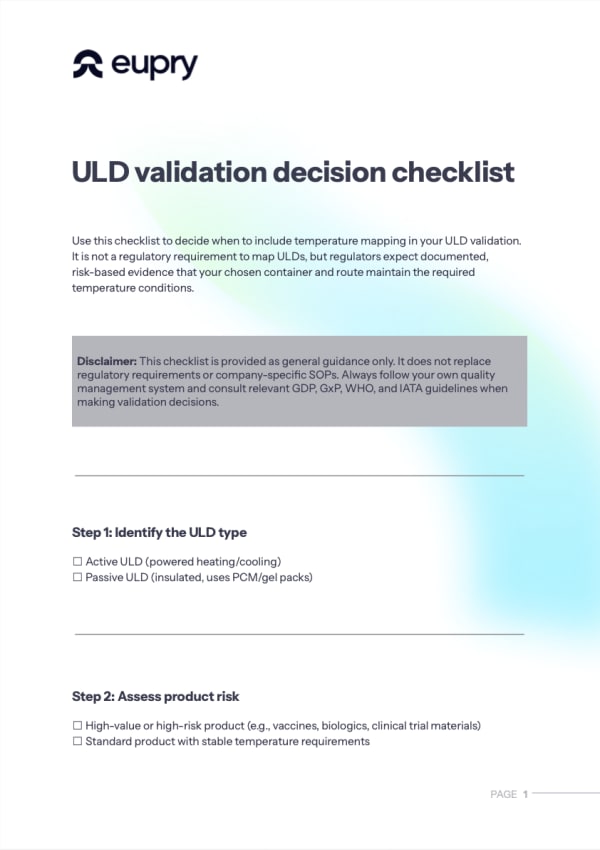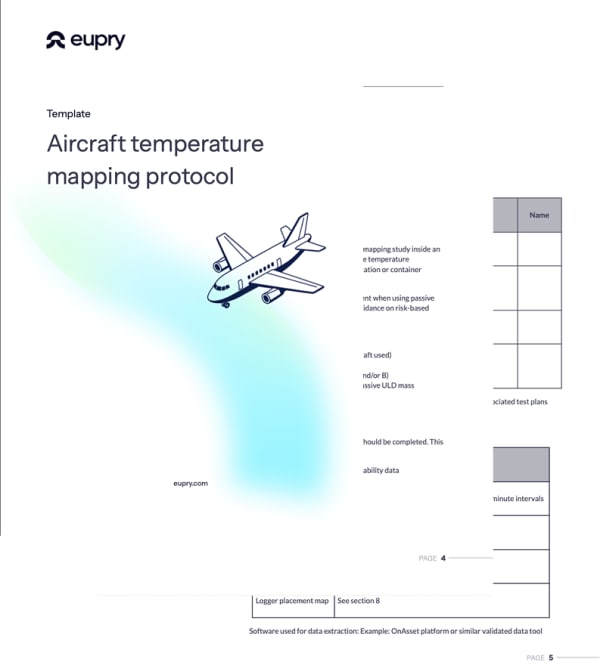Guide to Unit Load Devices (ULDs) in pharma logistics

Adam Hartmann-Kruckow
How validation supports regulatory compliance, sustainability, and safe transport
ULDs are the backbone of pharma air freight, but how do they support temperature-sensitive cargo? What is the difference between active and passive ULDs? And how do you validate their performance?
Get a step-by-step checklist to decide when to include temperature mapping in your ULD validation.

Unit Load Devices (ULDs) are essential to air cargo logistics — especially in pharmaceutical transport, where temperature control, cold chain validation, and GDP compliance are non-negotiable. As sustainability and cost-efficiency grow in importance, understanding the role and validation needs of ULDs has become a strategic priority.
Also read: Aircraft temperature mapping: What is it all about – and why do it?
What is a Unit Load Device (ULD) in pharma?
A ULD is a standardized container or pallet used to load cargo onto aircraft efficiently — and in regulated industries, to help protect product quality. In pharma logistics, ULDs serve a dual purpose: they simplify cargo handling and protect temperature-sensitive products during air transport.
There are two main types of ULDs:
- Active ULDs: Equipped with powered cooling and heating systems, often used for high-risk or ultra-cold chain shipments.
- Passive ULDs: Use insulation and phase change materials (PCMs) to maintain internal temperature ranges without external power.
What is ULD validation – and why does it matter?
ULD validation is the process of confirming that a ULD can maintain the required temperature conditions over the duration of a specific route or shipment scenario. It ensures that the container, passive or active, performs as expected under real conditions.
Validation is essential to:
- Ensure GxP and GDP compliance
- Reduce reliance on costly active ULDs
- Prevent temperature excursions that risk product quality
- Support route qualification and supplier evaluation
- Satisfy auditors and internal QA processes
Is temperature mapping required for ULD validation?
No. Temperature mapping is not a regulatory requirement for ULDs. Guidelines such as EU GDP, IATA CEIV, and WHO TRS expect that transport conditions are validated, but they do not mandate mapping of ULDs themselves.
Instead, mapping can be used as part of a risk-based validation strategy. This is especially relevant for passive ULDs on long-haul or high-risk lanes, or when introducing new routes.
For example:
- Mapping the interior of the ULD may be included in its PQ (Performance Qualification).
- Mapping aircraft zones helps determine if passive ULDs will stay within range in real conditions.
This approach aligns with the expectation that companies must demonstrate – with documented evidence – that their chosen container and transport setup consistently maintain required temperature ranges.
Also see: How to achieve your CEIV pharmaceutical compliance certification
Is ULD mapping relevant in pharma?
ULD mapping is not a formal requirement under GDP, GxP, or CEIV, but validation of transport conditions is expected in regulated pharmaceutical logistics.
Validation means demonstrating that the container and transport process consistently protect the product. For ULDs, this often includes:
- Verifying that the container (especially passive) performs under real-world conditions
- Documenting route- or lane-specific risks that could affect stability
- Evaluating aircraft zones to ensure they do not expose cargo to uncontrolled extremes
Mapping is simply one tool to provide that documented evidence. It can be highly valuable in risk-based validation strategies, especially when qualifying new passive ULDs or new air routes.
Also read: Temperature mapping in GxP environments

ULD validation decision checklist
Use this step-by-step checklist to decide when to include temperature mapping in your ULD validation.
Common ULD validation strategies
Validation approaches differ based on ULD type and shipment risk. In general:
- Active ULDs are typically pre-validated by the supplier. Validation focuses on configuration, SOPs, and handling.
- Passive ULDs require route-specific qualification and risk assessment.
Supporting data may come from:
- Manufacturer performance reports
- Internal validation protocols
- Temperature mapping studies (ULDs or aircraft zones)
- Lane-specific pilot shipments
Tip: Validation should always reflect real conditions — temperature, duration, handling, and storage during layovers.
When to use aircraft temperature mapping for ULD validation
Aircraft mapping is not required but can be a strategic tool in ULD validation. It helps demonstrate whether passive containers can safely fly on specific aircraft or routes.
Use it when:
- You want to reduce reliance on active ULDs
- You are validating new long-haul lanes or aircraft types
- Your QA or compliance team requires documented evidence
- There is limited or unclear data on aircraft thermal stability
Explore: Aircraft temperature mapping for pharma logistics
Use cases for ULDs in pharma logistics
Validated ULDs are essential across global pharma supply chains. Use cases include:
- Vaccines and biologics: Many require 2–8°C conditions and benefit from passive containers, if routes are validated
- Clinical trials: Small, high-value shipments require secure, stable transit
- Biotech specialties: Products with narrow temperature bands require strict control and documentation
- Sustainability and cost optimization: Replacing active ULDs with passive ones can cut emissions and cost — but only when validated
FAQ: Unit Load Devices (ULDs) in pharma logistics
Temperature validation solutions for pharma
Need help planning your ULD validation? Or any other GxP-regulated environment - from warehouse to ULTs and incubators?

Download an aircraft mapping protocol template
Aircraft mapping can be a step towards more efficient cargo and ULD use. Get a step-by-step protocol to help you plan and execute aircraft temperature mapping in alignment with GDP, GxP, and WHO Annex 9.